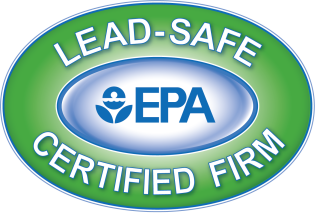Why is mold growing on your bathroom ceiling? How do you get rid of it? Bathroom ceiling mold removal can be a DIY project, but it’s a good idea to know when to call the professionals. How do you know when to clean and when to call? Come read and learn everything you need to know about bathroom ceiling mold.
DISCLAIMERS:
Blog information is NOT intended to provide or replace medical advice. NO information on this site should be used to diagnose, treat, prevent or cure any disease or condition.
*As an Amazon Associate we earn from qualifying purchases.
Suggestions for products to use are just that, suggestions. You know yourself and your home best. Please do your own research on any product you use in your home or on your skin, and learn all the facts for yourself. Thank you.
WHY DOES MOLD GROW ON MY BATHROOM CEILING?
Bathrooms are excellent places to grow some of your home’s worst enemies: mold and mildew. Excess moisture in your bathroom (or other areas of your home) causes mold and mildew to grow. Mold and mildew only need oxygen, a food source, and moisture to grow. Mold and mildew can damage the fixtures of the bathroom such as the drywall, trim, paint, doors, ceilings, and more because for the mold and mildew, these fixtures are a food source.
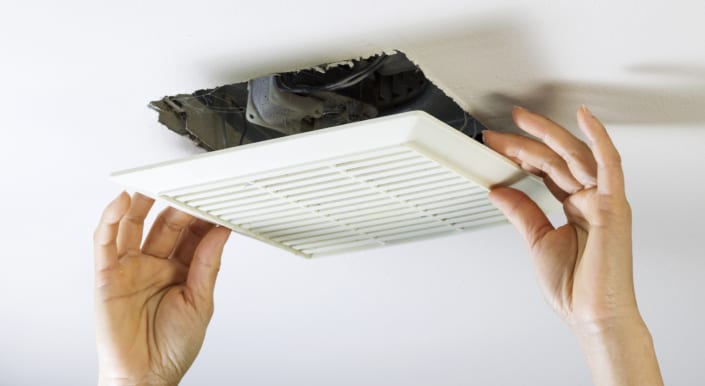
The most important feature of any bathroom fan is to remove moisture.
Most building codes now require a fan in every bathroom. Why? Because fans help ventilate the room, remove bad smells, and remove moisture. The most important function of the fan being to remove moisture. Even if the bathroom has a window, a fan is the best way to prevent moisture buildup.
Keeping your bathroom dry, well ventilated, and consistently using an exhaust fan is critical to preventing mold and mildew growth.
Not all bathroom fans are created equal! Be sure to choose a fan that is the right size for your bathroom. To learn how to get the correct size fan for your bathroom and more, check out our post: Bathroom Exhaust Fans – All You Need To Know.
WHAT CAUSED THE MOLD ON THE BATHROOM CEILING IN THE FIRST PLACE?
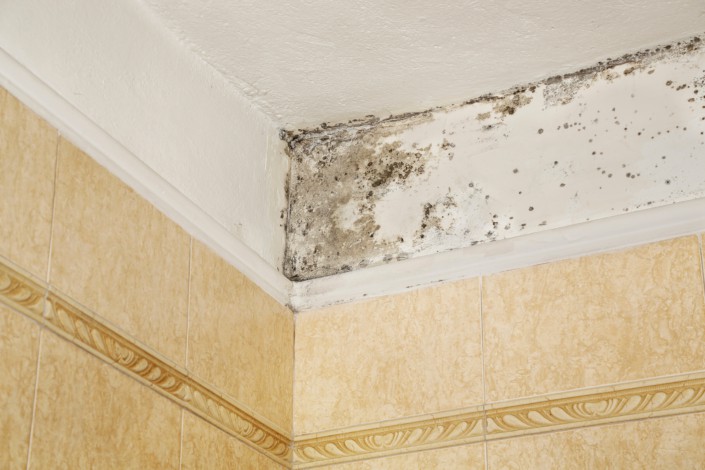
Before cleaning the mold, you need to do a little investigative work. If you don’t solve the moisture issue that caused the mold to grow, the mold will keep coming back! If you can’t determine the root cause of the problem, it’s time to call the professionals for a mold inspection.
Check out our post How to Choose the ‘Best’ Black Mold Removal Company before you call anyone! We let you know all the questions you should ask before hiring a professional mold inspector. The company you hire should know all the correct answers to the questions in our article. If not, don’t hire them!
Some questions to ask before cleaning mold include:
- Where is the mold located? Usually mold will grow in or near a place with lots of moisture, like your bathroom. Under sinks, behind cabinets, and between tiles are all places both moisture and mold can hide.
- Is this naturally a room with lots of moisture? Yes, bathrooms in particular are prone to mold and mildew growth because of the high moisture from baths and showers.
- Are there any leaking pipes, windows, or roof penetrations? Tiny leaks can cause as much or more damage as gushing water over time. Be sure to check for leaks and fix them before cleaning!
- Is the problem mold or mildew? Mold and mildew differ in the way they grow and what they look like.
How Do I Know if I Have Mold vs. Mildew?
Mold and mildew differ in the way they grow and what they look like. The biggest difference between mold and mildew is how they grow. Mildew only grows on the surface. Mold grows inside of it’s food source. Mold has to be removed completely not just cleaned.
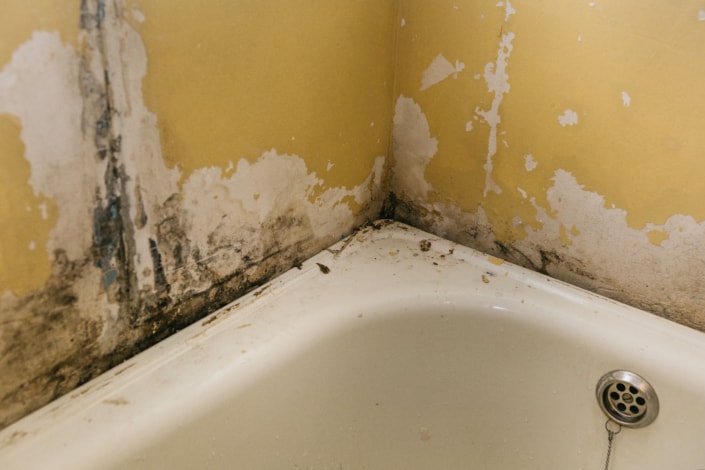
Mildew is always flat, and may begin white and then turn brown, gray or black. Mold is usually fuzzy and raised, comes in many colors, and always grows inside its food source. Mold can be many different colors ranging from white, yellow, green, gray, to black. In the photo above, mold is growing in the drywall surrounding the bathtub. All the drywall will have to be removed not just cleaned. This job is too big for a homeowner and should be performed by a professional.
BLACK MOLD – SOMETHING OF A MISNOMER
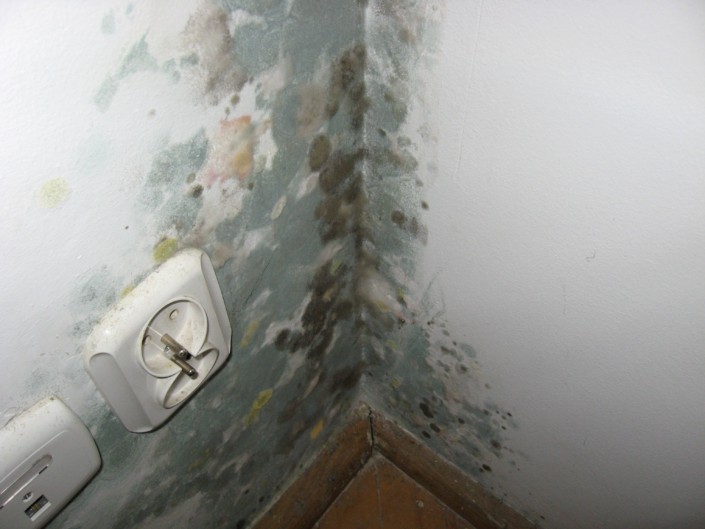
The thing is… dangerous and toxic mold is not just black, it can be many different colors. Toxic molds can appear to be green, yellow, brown, and black.
Before we go any further, we need to address a common misconception about mold. While all molds have the potential to cause irritation and allergy symptoms, some molds can also cause much more dangerous health problems. Some molds, but not all, produce toxins. Toxic molds can cause health problems ranging from poisoning to cancer. Not all molds are toxic, but many are. The thing is… dangerous and toxic mold is not just black, it can be many different colors. Toxic molds can appear to be gray, green, yellow, brown, and black.
So, where is the line between an allergic mold and a toxic mold? That line is defined by something called a mycotoxin, and is NOT defined by color.
Mycotoxins, literally ‘fungus poison’ in Latin, are secondary metabolites that can be produced by molds, and are not living organisms. Mycotoxins are a byproduct of mold. Not all mold spores produce mycotoxins, but some do. So the molds that produce mycotoxins are the ones that could be categorized as toxic or poisonous.
Mycotoxins are chemical substances that can cause many health problems ranging from mild to severe. Even if you are not allergic to mold, you can be affected by mycotoxins.
To learn even more about the health effects of mold check out our posts: Effects of Mold on Children’s Health and Mold and Mycotoxins: Effects on the Brain and Nervous System in Adults.
IS MOLD DANGEROUS?
In a word, YES. Toxic mold can make you very sick, but most people don’t realize how insidious it can be. Remember that the color of the mold (black, green, brown, etc.) does not determine it’s toxicity. Mold can cause health issues ranging from severe allergic reactions to mental health problems.
To learn more about the different health effects mold can have on adults, children and pets check out our post: Health Effects of Black Mold.
IS BATHROOM CEILING MOLD REMOVAL A DIY PROJECT?
Removing mold can be a DIY project, but it’s a good idea to know when to call the pros. Our tips for mold removal help you know what to use, and what not to use. We can help you remove the mold safely, whether you choose to DIY or call the professionals. We want to help you get back to living your best life with a clean mold-free bathroom!
What To Wear To Clean Mold Safely
Before even choosing a cleaning product, you should know what kind of safety equipment to wear to clean a moldy surface.
The basic equipment consists of an N-95 respirator, goggles or eye protection, & protective gloves with long cuffs. Long pants, a long sleeved shirt and waterproof boots are important to wear as well. Closed toed shoes are a good substitute for boots, especially if you are working on a small area of mold.
Mold is a respiratory irritant and allergen, so a mask with a N-95 respirator is important, especially if you know you are allergic to mold. A simple dust mask will NOT protect you from the mold spores.
For more information about safety, visit: What to Wear before entering a Home or Building with Mold Damage by the CDC.
To learn more about face masks see our post: In-depth Guide to Face Masks: Allergies, Grass Cutting, and COVID-19.
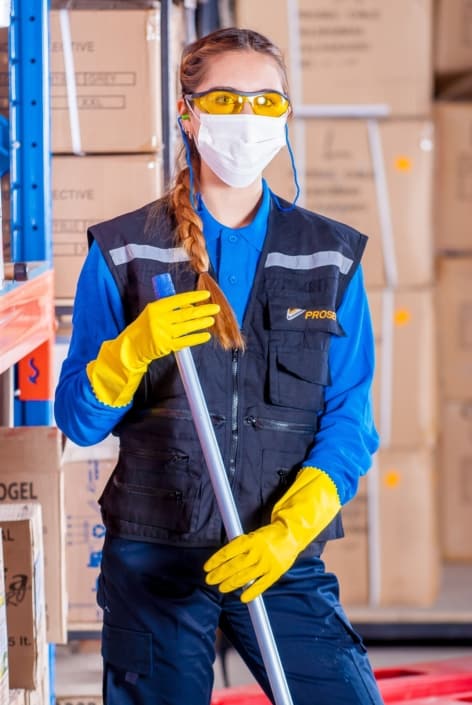
What Not To Use – Bleach
The goal of mold cleaning is not to kill mold, or even to disinfect a surface or material, but rather to remove mold from a surface. Think of mold more like dirt. If you had a wall with dirt on it, would you simply spray it with bleach and consider it cleaned? Of course not.
Bleach is a combination of chemicals used to kill bacteria and whiten clothes, floors, and walls. Bleach contains sodium hypochlorite which is toxic to bacteria, fish, and human beings. In fact, the Environmental Protection Agency (EPA) discourages the use of bleach and biocides for mold cleaning.3
Of course, there are more reasons to avoid bleach. Bleach is designed to kill bacteria, and will not completely remove a mold problem. Molds are fungi and they can, and will, grow back after bleaching.
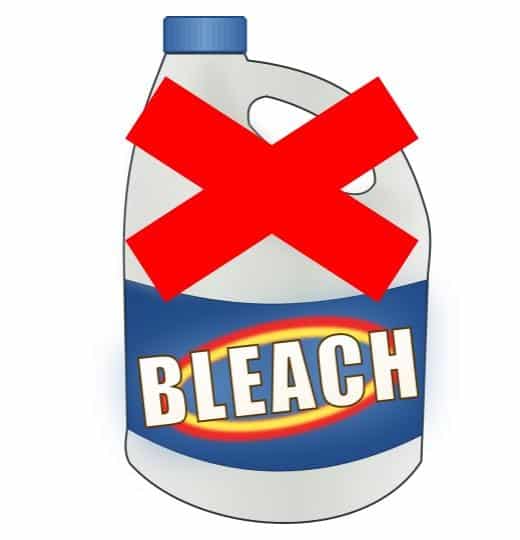
There are 3 simple ingredients you, probably already have on hand, that can safely use to clean away mold in your home.
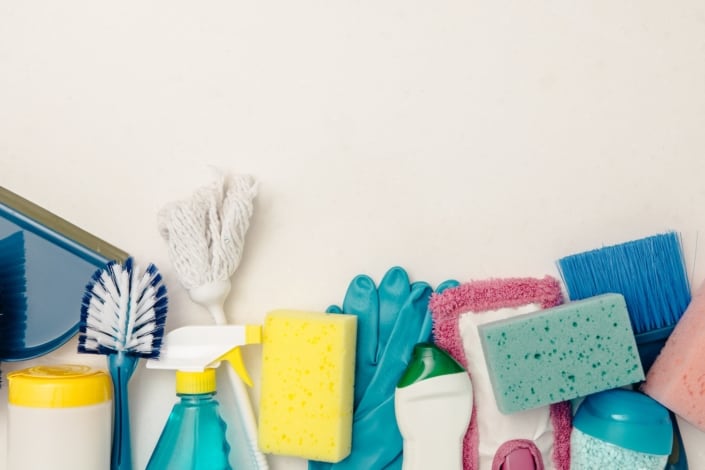
What about all of the mold cleaners that are being marketed? What about the claims that a certain product kills mold, removes mold, removes stains, disinfects surfaces and prevents mold from ever returning? If it sounds too good to be true, it usually is.
There are 3 simple ingredients you can safely use to clean away mold in your home: white vinegar, baking soda, and hydrogen peroxide. Remember NOT to mix these ingredients! Keep reading for maximum cleaning power and safety!
Hard Surface Cleaning
To clean a hard surface (like a shower stall, tiles, toilet, sink, or floor), simply add hydrogen peroxide OR white vinegar to a clean, empty spray bottle undiluted. Never mix these chemicals! Choose one or the other.
Hydrogen Peroxide
When using hydrogen peroxide, spray the area to clean thoroughly, and let it sit for 10-15 minutes. Then, scrub the area, and rinse it clean with water. Repeat if needed.
White Vinegar
For white vinegar, spray the area to clean thoroughly, and let it sit for at least 15 minutes or up to one hour. Then, scrub the area, and rinse it clean with water.
Baking Soda
To use baking soda, add a teaspoon to a tablespoon of baking soda to a clean empty spray bottle and fill the bottle ¾ full of hot water. Shake to dissolve. Spray the area and use a scrub brush to clean the mold away. Then, rinse the area with clean water.
When using baking soda, it usually works best with a white vinegar spray following the baking soda, but not at the same time. The baking soda should be scrubbed away and rinsed before spraying with vinegar.
Baking soda is a base and vinegar is an acid. When they are used together, they react to form carbon dioxide gas and heat. The chemicals then are neutralized (changed to a neutral pH of 7) and have less cleaning power than they would if they had been used separately.
Essential Oils
You can add 5 to 10 drops of tea tree essential oil to the white vinegar spray to increase the disinfectant power. Tea tree essential oil is distilled from the Melaleuca alternifolia tree from Australia. The essential oil is antifungal (kills fungi), antiviral (kills viruses), and antimicrobial (kills microbes, including bacteria). We advise people with allergies or asthma to use this oil with caution, as it can be irritating to the skin and lungs. To learn more about essential oils and how to use them safely check out our post: Essential Oils For A Healthy Home.
Cleaning Softer Surfaces
Hard surfaces generally are able to be cleaned, and most of the time mold will not grow back if it is completely removed and the moisture problem has been fixed. Soft surfaces (such as carpet, drywall, upholstered furniture, etc), are not always able to be cleaned completely enough to keep the mold from coming back. These types of material are such that the mold can easily penetrate making it difficult to remove.
Linens, clothes, and towels can be laundered in hot water to remove the mold, but stains may remain.
When you have softer surfaces such as carpet and drywall that have been contaminated with mold, it’s probably time to call a professional. It is very difficult to tell just how much of the surface has really been invaded by the mold just by looking.
Best Commercially Available Mold Removal Products
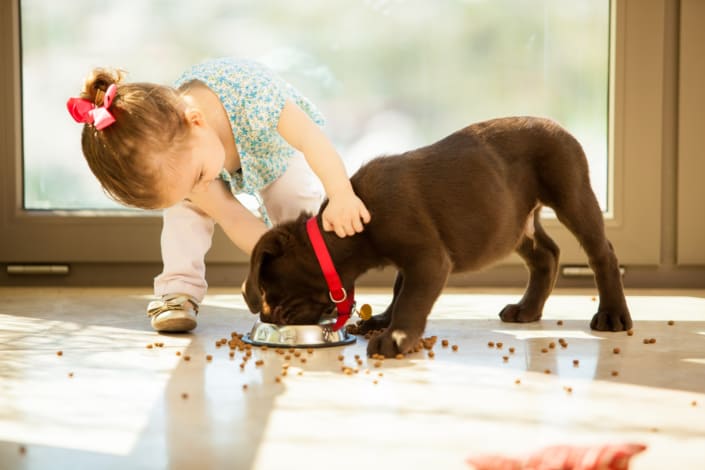
The best mold removal products are those that are non-toxic and safe to use around children and pets.
There are 2 commercially available mold removal products that we recommend. Both are cleaners that are safe to use in your home and near children or pets. Remember that you should always wear personal protective equipment when cleaning mold, no matter how safe your cleaner may be.
The first is Concrobium Mold Control Cleaner. You can check out the EWG’s Guide to Healthy Cleaning | Concrobium Mold Control Cleaner Rating here.
The other product we recommend has not been reviewed by EWG, however, it is an excellent and safe product that we can highly recommend. Bioesque Botanical Disinfectant Solution kills fungi and mold within 3 minutes. It also kills bacteria and viruses including COVID-19.
To learn more about this product and its safety check out the company’s website at: Bioesque’s Botanical Disinfectant Solution.
No matter what product you choose, be sure to wear proper safety equipment, ventilate the room to the outdoors, and follow all product directions.

It smells good. It’s clean, right? – Mold on Bathroom Ceiling

Wrong! Smelling good does NOT indicate that something is clean! In fact ‘fragrance’ can be anything in a product that gives it a smell from essential oils from plants to industrial petrochemicals.7
Cleaning and personal care product manufacturers are required to list their ingredients on the label of the products.7 However, because of a loophole in government regulations (specifically the Federal Fair Packaging and Labeling Act of 1973), they are not required to list any fragrance ingredients.10 This means that they can use any chemical they choose to add smell to a product, including dangerous, allergenic, and even toxic chemicals.10
To learn more about hidden fragrance chemicals in personal care products go to: EWG Not so Sexy – Hidden Chemicals in Perfume and Cologne.10
Our government does not regulate personal care products or cleaning products in a way that allows consumers to have all the facts about a product before they use it.7 Because of this, we urge you to learn all you can before using any product in your home.
Cleaning products affect air quality, especially if ventilation is not used during cleaning. Remember to always use good ventilation when using any cleaning product.
To learn more about the products you use to clean your home, and how they are NOT regulated by the federal government check out our article: Cleaning Products – Homemade vs. Store Bought.
Tips For Cleaning Mold
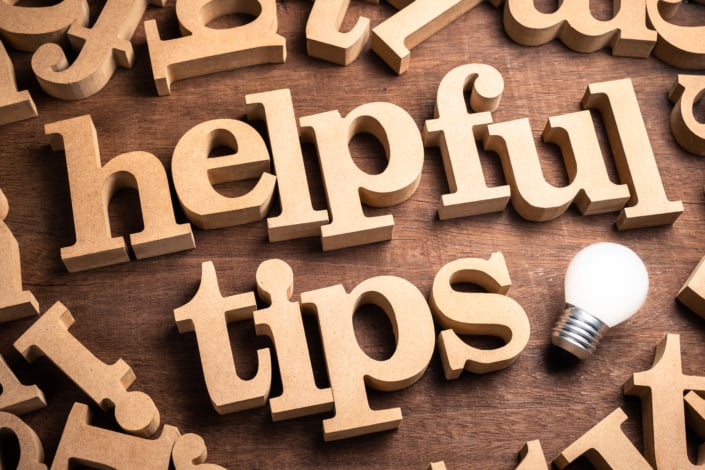
- Remember that your goal is not to kill the mold spores, but to remove them. When they have been removed completely they cannot grow back.
- Ventilate, ventilate, ventilate! Ventilation is important when cleaning mold, so that any disturbed spores exit the building. Close and tape off doors to the rest of the house and use a box fan in a window pointing out while cleaning. This will prevent spores from invading the rest of the home, and removes them from the air of the room to be cleaned.
- Be sure to spray and then wipe all surfaces with a damp rag. Dry wiping will disturb spores and send them into the air! Airborne spores can regrow in new locations, and cause even more mold to grow. Mold spores are not visible to the naked eye, so be sure to cover all surfaces with your cleaner of choice, even if they look ‘clean’.
- Vacuuming is not the best method of removal. Do NOT use a vacuum to clean mold unless you have a vacuum with a HEPA filter. HEPA stands for high-efficiency particulate air, which means the filter can stop most particles of dust, pet dander, allergens, etc. that are 0.3 microns or larger and keep them from being put back into the air. The HEPA filter should be changed periodically to increase efficiency. Use with caution as mycotoxins may not be filtered out even when using a HEPA vacuum. Remember that you will eventually have to empty the vacuum, and it will be filled with the mold.
KNOW WHEN TO CLEAN AND WHEN TO CALL
Remember with mold or mildew, there are four steps to take for remediation:
- Check for and fix leaks and ventilation issues. The bathroom in the opposite photo did not have leaks. However, it also did not have a bathroom fan. Moisture built up and caused damage to the ceiling.
- Get a professional inspection if you suspect the problem may be more than an isolated area. If you see areas larger than about ten square feet, or there is a musty smell you can’t identify, it may be time to call the professionals. A professional mold inspection can ensure your problem is solved and not just covered up.
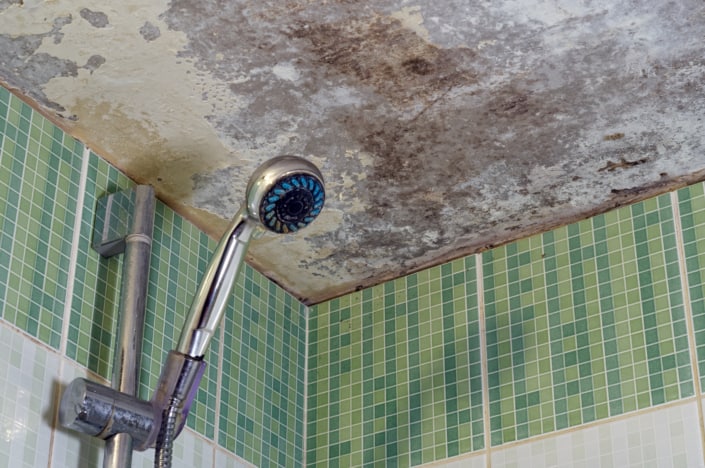
- Clean what you can see, if it’s a small area (less than 10 sq.ft.), and on a hard surface. Baking soda, white vinegar, and hydrogen peroxide are excellent cleaners (used separately) and can help remove the surface mold and mildew. For more information check out our post – Bathroom Mold Remover – How to Choose the Best and DIY Safely.
- Prevent new growth. Keep areas of high humidity dry by ventilating rooms such as bathrooms, kitchen, and laundry rooms. Dehumidifiers may be helpful. To learn more about bathroom exhaust fans check out our post: Bathroom Exhaust Fans – All You Need To Know.
Remember, mildew is a surface dweller and easily removed. Mold grows inside of the food source (carpet, drywall, etc.), and can cause major health issues. If you clean an area and the fungal growth comes back quickly, you may have a mold problem. A professional inspection can determine the true source of the problem and fix it.
HOW CAN I PREVENT BATHROOM CEILING MOLD?
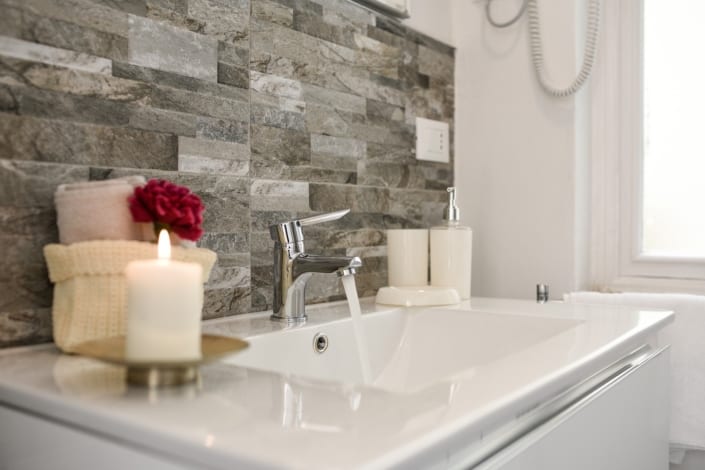
Mold loves warm, wet places just like your bathroom ceiling. How do you prevent mold from growing? Just 3 words – Keep It Dry! Ventilation fans are extremely important to prevent mold. The fans reduce moisture and heat levels in the bathroom dramatically… if people use them.
To learn more about ventilation in bathrooms check out our post Bathroom Exhaust Fans – All You Need To Know. We even include tips on how to get fans used in your home!
For even more tips on preventing bathroom mold check out our post: How to Prevent Bathroom Mold. We’ve got tips on how to ‘Keep it Dry,’ and more information about home renovation projects that can reduce mold.
WE’RE HERE WHEN YOU NEED US
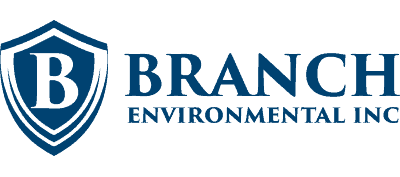
Having trouble with your indoor air quality? Call Branch Environmental. We’re experts at indoor air quality assessment. We treat each inspection as an investigation. As a company, we believe that no one should live or work in a building that makes them sick. From hidden mold sources to major contaminants, we can identify exactly what is going on in your home and rid it of environmental toxins, often for good.

